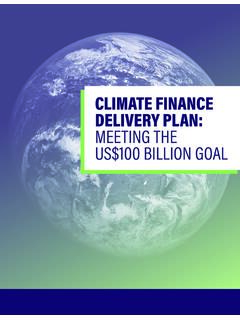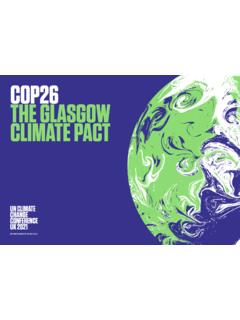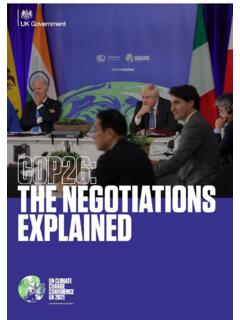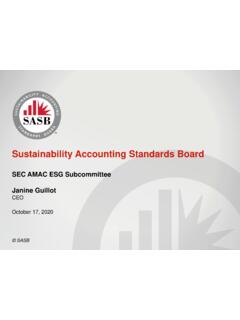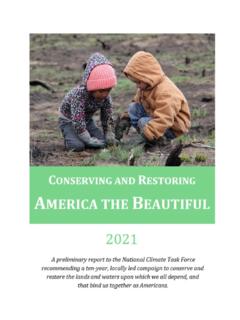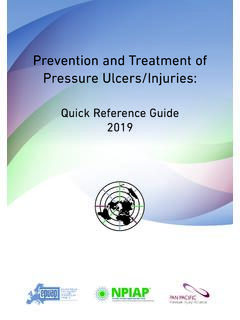Transcription of BUILDING A PRIVATE FINANCE SYSTEM FOR NET ZERO
1 BUILDING A PRIVATE FINANCE SYSTEM FOR NET ZERO Priorities for PRIVATE FINANCE for COP26 Mark Carney, UN Special Envoy for Climate Action and FINANCE and the Prime Minister's FINANCE Adviser for COP26 2 BUILDING a PRIVATE financial SYSTEM for net zero CONTENTS Executive summary Scope & objectives 5 Context 6 Summary of goals and deliverables 12 Deliverables in detail Reporting 14 Risk management 17 Returns 22 Mobilisation 26 3 BUILDING a PRIVATE financial SYSTEM for net zero BUILDING a PRIVATE financial SYSTEM for net zero EXECUTIVE SUMMARY 5 BUILDING a PRIVATE financial SYSTEM for net zero Achieving the objective agreed in the Paris Agreement to limit global temperature increases to below 2 C from pre-industrial levels requires a whole economy transition every company, bank, insurer and investor will have to adjust their business models.
2 Develop credible plans for the transition and implement them. In recognition of the scale of the task, 125 countries, including half the G20, have now committed to net zero by 2050 at the There is a clear opportunity to invest in a green, resilient recovery as countries seek to recover from the pandemic. Achieving climate goals will require all forms of FINANCE . Public and blended FINANCE , including the important commitment made by developed countries to mobilise $100bn annually by 2020 for climate FINANCE ,2 have a vital part to play in the shift to a greener more resilient economy and a fair transition for society. They will contribute to critical infrastructure development, support adaptation and resilience, and help develop new markets for PRIVATE FINANCE by de-risking investment. And mainstream PRIVATE FINANCE will help all companies realign their business models for net zero.
3 It will fund the initiatives and innovations of the PRIVATE sector and turn billions committed to climate investment through public channels into trillions of total climate investment. The COP26 PRIVATE FINANCE Hub, led by Mark Carney in his capacity as UN Special Envoy and Adviser to the Prime Minister, will focus on BUILDING a SYSTEM that mobilises PRIVATE FINANCE to support the re-engineering of our economies for net zero. The objective for the PRIVATE FINANCE work for COP26 is simple: ensure that every professional financial decision takes climate change into account. This requires the right framework so that the financial sector can allocate capital to manage risks and seize opportunities in the transition to net zero. To this end, the COP26 PRIVATE FINANCE Hub will work with the PRIVATE sector and other stakeholders to develop: Reporting: improving the quantity, quality and comparability of climate-related disclosures by implementing a common framework built on the Taskforce for Climate-related Financial Disclosures (TCFD) recommendations.
4 Risk management: ensuring that the financial sector can measure and manage climate-related financial risks. Returns: helping investors identify the opportunities in the transition to net zero and report how their own portfolios are aligned for the transition. Mobilisation: increasing PRIVATE financial flows to emerging and developing economies, by connecting available capital with investable projects and encouraging new market structures. SCOPE & OBJECTIVES 1 See: 2 See: 6 BUILDING a PRIVATE financial SYSTEM for net zero CONTEXT COP26 will be a significant milestone for the transition to a sustainable future. All countries are expected to increase the ambition of their Nationally Determined Contributions (NDCs) against the temperature goals agreed in They will do so during unprecedented tests of their health and economic systems.
5 While the pandemic has meant that COP26 has had to be postponed, its ambition has not been scaled down. Global emissions, while lower than last year, will still deplete more of the remaining carbon budget. Countries revised NDCs, long term strategies and post-COVID recovery plans need to support the whole-economy transformation required to achieve net zero. As countries turn Paris commitments into legislated objectives and concrete actions, they will provide certainty to the market and help crowd in PRIVATE investment. FINANCE will be critical to accelerating and smoothing this transition both by funding PRIVATE sector initiatives and by amplifying the effectiveness of government climate policies. A transition to net zero will affect how risk is measured and managed and how assets are valued. The UK will make all forms of FINANCE a focus of its COP26 presidency.
6 The focus for the PRIVATE FINANCE work is to build the right framework so that the sector can allocate capital to manage climate risks and seize climate opportunities. Recognising that net zero is both an imperative of climate physics and a public commitment in 125 countries, financial markets, regulators and consumers are increasingly demanding information about how companies are managing climate risks and pursuing opportunities: Banks, insurers, pension funds and investors with balance sheets of $139 trillion are demanding TCFD-aligned climate disclosure from Investors increasingly recognise that climate risk is investment risk, and they want to know every firm s plan for managing these risks .5 75 central banks covering 60% of global emissions are now members of the NGFS, a group dedicated to improving the management of climate risk in the financial sector, and 13 central banks are in the process of stress testing their financial systems to assess individual and collective resilience to climate risks.
7 Climate Action 100+, a group of over 500 institutional investors controlling over $47 trillion of assets, are demanding that the world s 161 highest-emitting companies (representing 80% of industrial emissions) publish strategies to reduce emissions by 45% by 2030 and to reach net zero by 2050. They have also called on these firms to 3 See: 4 The full list of current TCFD supporters is available at: 5 See: 7 BUILDING a PRIVATE financial SYSTEM for net zero publish medium-term targets and disclosures in line with a new benchmark to show progress, threatening action if they don t see sufficient progress in the next 12 In an open letter, six of the largest investor alliances, representing assets worth over $103 trillion called on companies and auditors to fully reflect the effects of climate change in their declared results and ensure any assumptions made when preparing financial statements are compatible with the Paris Boards are increasingly under pressure to be transparent with investors, clients and colleagues about the impact of climate change.
8 The number of climate-related resolutions tabled by investors has doubled since 2011. The percentage voting in favour has tripled over the same A recent survey found that 70% of savers want their investments to consider the impact on people and planet alongside financial The Make My Money Matter campaign is giving people a means to ask their pension providers to invest in line with net zero. And 9 in 10 millennials believe the success of a business should be measured by more than its bottom The financial sector and real economy are both increasingly focused on implementing plans to achieve net zero: The Net Zero Asset Owner alliance , whose members commit to transitioning their investment portfolios to net-zero greenhouse gas emissions by 2050, now represents $5 trillion in assets under management.
9 Asset owners have agreed to implement deep GHG emissions reductions in their portfolios by up to 29% by 2025. They have stated that they will work with those willing to adjust their business models, and do not wish to engage in a divestment The TCFD has nearly 1,500 supporters from 55 countries, with a market capitalisation of over $ The supply of climate disclosure is responding to the demands of investors. The International Business Council (IBC) of 140 CEOs agreed a common set of metrics that IBC members signed up to 6 See: 7 See: 8 See: FT Energy Source 9 See: 10 See: 11 See: 12 See TCFD website Sept 2020: 8 BUILDING a PRIVATE financial SYSTEM for net zero disclose, which included TCFD. And the 3,038 signatories of the UN Principles for Responsible Investment must make TCFD disclosures or risk ejection from the The Science-Based Targets Initiative has approved almost 500 company emissions targets as consistent with the Paris Agreement, and this number is growing The initiative continues to work with the over 500 more companies to increase their ambition for approval.
10 The Race to Zero coalition, representing 452 cities, 22 regions, 1,101 businesses, 45 of the biggest investors, and 549 universities, is the largest ever alliance committed to achieving net zero carbon emissions by 2050. Collectively these actors now cover nearly 25% of global CO2 emissions and over 50% of The PRIVATE sector-led Taskforce for Scaling Voluntary Carbon Markets is consulting on a blueprint of the market infrastructure required for a scalable, liquid, transparent and reliable voluntary carbon market, and a roadmap to implementation. The transition to Net Zero is creating the greatest commercial opportunity of our age. Globally, the benefits of shifting to a low-carbon pathway are estimated at $26 trillion by 2030 compared to our current high-carbon But shifting the global energy SYSTEM towards a well-below 2 C pathway requires a significant redirection of global investment flows.

